Basic knowledge
Explained Simply
Due to its position in the room and its surface area, the ceiling offers ideal conditions for a radiant heating system.
The intervention in the room geometry is minimal compared to any other surface in the room.
A particular advantage of the ceiling is that it can also be used optimally for room cooling.
Physical Principles & Functionality
How and why does a climate ceiling work? This can be most easily explained using physical principles.
In addition to visible light rays, the sun also emits invisible infrared rays – the so-called thermal radiation. On its "journey" over 149,600,000 km, it first passes through the vacuum of space and then the last 100 km of Earth's atmosphere. Heat transfer only occurs when these rays hit a solid surface – for example, the ground or the skin of a living being.
Two facts become immediately clear:
1. Thermal/infrared radiation transfers energy over great distances.
2. Air plays no role in energy transfer.

Here is another important physical fact: Every surface emits heat. The thermal radiation of objects (e.g., the Earth's surface) behaves exactly like the sun's rays. They penetrate the air without heating it and transfer their energy directly to other surfaces. The rule is: Hot surfaces emit more heat than cooler surfaces. Through mutual radiation exchange, the temperatures of all surfaces equalize over any distance. We use these physical laws with the climate ceiling for heating and cooling. Just like the sun, but much gentler, because we work with very small temperature differences.

|
Hot surfaces emit more heat than cooler surfaces. |
The hot surface transfers more thermal radiation than it receives in return from the cooler surface. |
The hot surface cools down and the cool surface warms up. The temperature of both surfaces equalizes, regardless of the distance, and without tempering the air. |
Heating - Radiation Versus Convection
Simply put, the higher the proportion of radiation, the more comfortable and economical it is to temper a room with the system. This means that only the fully activated climate ceiling leads to the best possible results. The Klima-Top climate ceiling shines with 97% radiation proportion (source: ... with link) and consequently with top values in flexibility, economy, efficiency, and room climate, which can also include acoustics if desired.
A significant role is played by the chill effect. This refers to the air movement in the room caused by a convection heater. The cause is the room air temperature and the surface temperatures of walls, floors, and ceilings. With radiators and underfloor heating, the air temperature is up to 5° higher than the surface temperature of the surrounding room envelope. This creates air currents in the room, which essentially produce the cooling effect of a fan, known as the chill effect. This chill effect means that the room air temperature with underfloor heating must be about 4 Kelvin higher than with a fully activated climate ceiling (source: ... with link).
The cause of the chill effect of underfloor heating can be easily described.
1. With underfloor heating, the temperature of the ceiling surface is lower than the temperature of the floor surface. This means that the air at the ceiling cools down, becomes denser, sinks down, and in turn displaces the warmer air at the floor upwards.
2. Underfloor heating can rarely act as a full-surface heater because furniture, carpets, or other furnishings in the room prevent this. This leads to uneven heating of the room and increases the formation of air turbulence in the room.
As described above, increasing the room air temperature by 1 degree Celsius requires 6.5% more energy (source: ...), which clearly shows the immense advantage of the climate ceiling. With a difference of 4 Kelvin between underfloor heating and climate ceiling, this alone results in an energy-saving potential of 26% in favor of the climate ceiling. In addition, there is a significant reduction in the supply temperature with the climate ceiling, which can be over 10 Kelvin. This results in a further energy-saving potential of 20% (2% per Kelvin -source: ... with link), so that the saving potential in this example sums up to 46%.
Last but not least, the climate ceiling has another significant advantage. Since the surface temperature in the room is higher than the room air temperature, no moisture can condense on the walls. Instead, the walls are dehumidified, which improves the insulation value and building protection.
Cooling – Radiation Versus Convection
For cooling, the radiation exchange is simply used in the opposite direction. The heated surfaces emit a lot of heat. The climate ceiling absorbs this radiation and removes it with its cooling water. The climate ceiling tackles the problem at its root. It works silently and, above all, without unpleasant and health-threatening drafts.
The climate ceiling can be supplemented by controlled residential ventilation. This dehumidifies the air during hygienic air exchange and thus enables very flexible air conditioning.
An air conditioner, on the other hand, only fights the symptoms. It blows cold air into the room, but the walls remain warm and continue to emit a lot of heat. This leads to a very ambivalent body feeling: we sweat because of the thermal radiation and shiver because of the cold air. This leads to discomfort after a short time and significantly increases the risk of catching a cold.
Understanding and Creating a Comfortable Room Climate
We perceive the thermal room climate as pleasant when our body can maintain its core temperature of around 37°C with minimal effort, meaning it neither has to give off nor produce additional heat to maintain the core temperature. Our body has the following three measures available for temperature regulation:

- Sweating: In hot conditions, sweat evaporates from the skin, thereby removing heat from the body.
- Shivering: In cold conditions, shivering generates heat through muscle contractions.
- Blood circulation: In hot conditions, the skin is more heavily perfused to release heat, while in cold conditions, it is less perfused to reduce heat loss.
Strictly speaking, temperature regulation is not about warming the body, but optimally controlling its heat emission. This is achieved in two ways: through convection and radiation exchange.
In winter, when the surrounding surfaces are very cold, the body emits a lot of heat to them. Conversely, if the air is very cold, the body cools down too much through convection.
Heat loss can be reduced in two ways: by limiting convective heat emission by warming the air, and by reducing heat emission during radiation exchange by warming the surfaces. Both methods can restore thermal comfort but lead to completely different temperature distributions in the room.
When heating convectively, two negative effects can be observed:
1. The descending draft is very uncomfortable, especially at the windows.
2. Warm air accumulates at the ceiling, where it is of no use to anyone, and cold air spreads at the floor. This leads to overheating the room air, which negatively affects both energy costs and comfort.
And what is different about the climate ceiling?
In contrast, full-surface climate ceilings achieve a very even temperature distribution in the room: Through radiation exchange, the surfaces in the room are evenly and gently warmed and remain consistently warmer than the air. As a result, the air also warms up at the warmer floor and wall surfaces, but only very slightly. It rises slowly and can no longer cool down at the climate ceiling. Therefore, the air does not circulate but forms stationary air layers with minimal temperature differences.
This leads to three positive effects:
1. The air remains pleasantly tempered, largely dust-free, and fresh even in a comfortably tempered room.
2. Convection is reduced to a minimum, avoiding unwanted side effects such as wind chill from descending cold air.
3. Human heat emission can be very precisely regulated with this even temperature distribution, without overheating the room or accepting uncomfortably cold zones.
Comfortable and Healthy Cooling
The air conditioner roars, cold air constantly flows onto the neck... There are still far too many such workplaces and hotel rooms. Fortunately, ceiling cooling is now standard in new office buildings. What is beneficial at the desk is also a blessing for shops and homes: absolutely silent cooling without drafts.
In summer, the sun's rays penetrate the window panes and transfer their heat to all surfaces they hit in the room. These surfaces warm up and emit heat into the room. Together with the waste heat from devices and people, the room temperature rises uncontrollably above the outside temperature and becomes uncomfortable to unbearable.
Convective Cooling
Cooling a room with cold air primarily focuses on lowering the air temperature. However, human heat emission is mainly ensured by thermal radiation to cooler surfaces. If these surfaces remain too warm, the body's natural thermoregulation is impaired, and the body has to sweat more.
Strong cooling and the associated drying of the breathing air impair the natural moisture of the mucous membranes. This promotes the proliferation of viruses and bacteria and increases the risk of colds. Additionally, constant drafts can lead to tension and discomfort.
Cooling through Radiation Exchange
While air conditioners primarily cool the air, the climate ceiling goes a step further. By continuously cooling the entire ceiling surface, the thermal radiation we emit is directly absorbed. This creates a pleasant room climate without drafts or unpleasant noises, and the cool surfaces enable natural heat regulation of the body without sweating. Thus, the climate ceiling ensures a very pleasant and healthy room climate even at high outside temperatures, promoting both relaxation and performance.
What Is Better than a Climate Ceiling?
The climate ceiling in combination with controlled ventilation. This ensures hygienic air exchange with pre-cooled air and achieves this with such low air exchange rates that comfort is not impaired. The great advantage is that the air is dehumidified in the process. Thus, the climate ceiling can cool the room significantly without causing condensation or humid air. You get the best of both worlds: high cooling performance with pleasant humidity without cold drafts. This allows the climate ceiling to unfold its full potential.
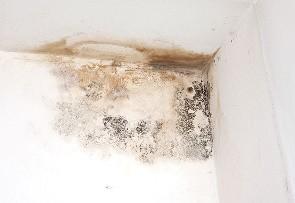
Goodbye Mould
Mould often forms due to cold walls, overheated room air, and high humidity. Climate ceilings turn the tables: they warm the walls while keeping the room air cooler, thus reducing the risk of condensation. The result: a dry, healthy room climate without the risk of mould.
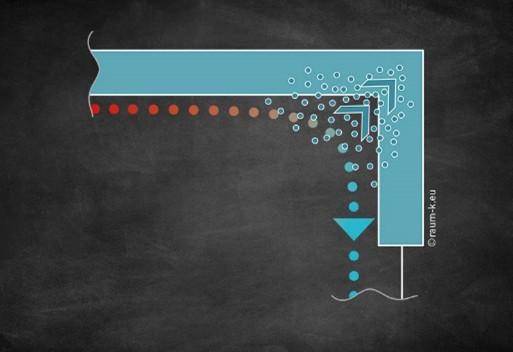
Convective Heating – Warm Air Meets Cold Surfaces
With radiators and underfloor heating, the heat flow runs from the radiator through the air to the room envelope. Therefore, the air is always warmer than the room envelope. On its "journey" through the room, the warm air constantly encounters the cooler room envelope, cools down, and reaches a higher water saturation. If this process is not stopped in time, the saturation limit of the room air is exceeded and the excess water vapor condenses on the cooler surfaces. This moisture then penetrates the masonry and causes damp spots or even mould formation if not addressed.
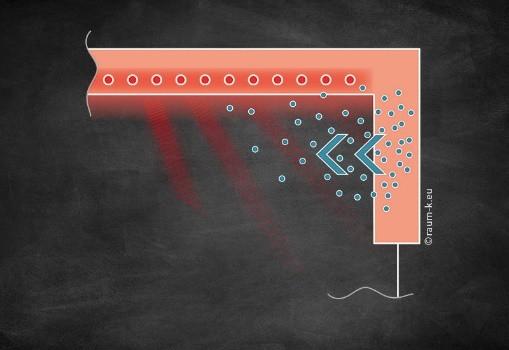
Climate Ceiling – Cool Air Meets Warm Surfaces
With the climate ceiling, the heat flow is opposite to that of convection heating. It warms the surfaces in the room directly, instead of taking the detour through the air. This reduces the relative humidity, preventing the formation of condensation, depriving mould fungi of their breeding ground, and thus contributing to a healthy living climate.
Health Protection through Minimal (Fine) Dust Exposure
Why is this aspect so important? Because an adult takes approximately 23,000 breaths a day, allowing about 15,000 litres of air to flow through their lungs. This air contains mainly household dust, an extremely unappetizing mixture of mite excrement and other harmful particles. Allergy sufferers can tell you a thing or two about it. With the fully activated climate ceiling, you can breathe freely again in your rooms and enjoy fresh indoor air.
Underfloor Heating Causes an Air Roll
The air warms up at the warm floor and rises. At the cold ceiling and wall surfaces, the air cools down again and falls back to the floor, where the process starts anew. The air circulates at high speed, stirring up household dust from the floor and distributing it in the breathing air.
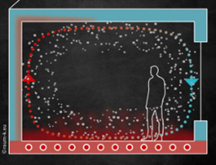
The Full-Surface Climate Ceiling Avoids an Air Roll
A climate ceiling warms all surfaces in the room, thus preventing the formation of an air roll. Through gentle warming at the warm surfaces, the air rises slowly. Once it reaches the ceiling, it cannot cool down and therefore cannot form an air roll.

Understanding and Avoiding Wind Chill
Drafts can feel unpleasant even at comfortable air temperatures. The passing air increases the evaporation rate and cools the body down. This effect is stronger the faster the air flows and the colder it is.
Window areas are particularly affected, where circulating heating air cools down and falls to the floor. Therefore, many offices are not used up to the glazing to avoid uncomfortable and unhealthy workplaces.
A climate ceiling avoids wind chill as it does not heat convectively. The air is not circulated and does not cool down anywhere. The result is almost still air with a very even temperature distribution throughout the room. This makes window seats comfortably warm even at lower temperatures and can be used as office space up to the glazing.
Underfloor Heating
Airflow speed
Climate Ceiling
Airflow speed
Source: DIN: HTCO GmbH Freiburg
Economical in Investment and Operation
A good indoor climate doesn't have to be expensive. On the contrary, the combined heating and cooling function of a climate ceiling reduces the scope of the system technology compared to two separate systems.
This often makes climate ceilings the most cost-effective choice for full air conditioning, even at the investment stage. Not to mention the economical operation
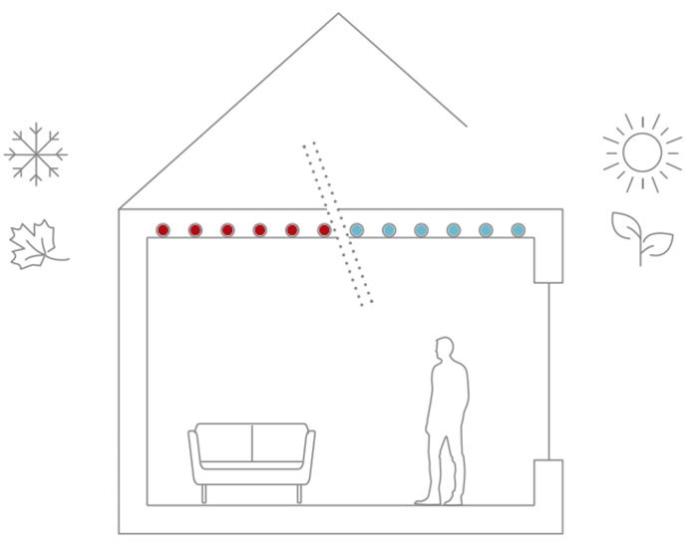
Reduced Heating Demand
Climate ceilings are the only transfer systems that operate with almost 100% radiant heat:
They avoid convection and temper the surfaces. Therefore, the heating demand must be calculated differently for climate ceilings.
According to DIN, the heating demand is generally reduced by 15% when using full-surface climate ceilings. However, this value is very conservatively chosen, as calculations according to recognised technical rules often result in a heating demand reduced by up to 30%, which is also confirmed in practice.
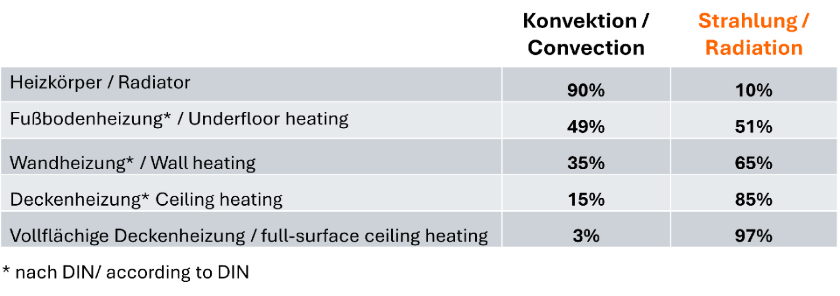
Comfortable Indoor Climate at Reduced Room Air Temperature
If the room envelope is warm, a room is still perceived as comfortable even with cooler room air.
This fact is utilised by the climate ceiling for particularly economical heating operation: While convective heating systems expend a lot of energy to heat the entire air volume, climate ceilings primarily temper the surfaces. This is more efficient and wastes less energy during air exchange. After all, the heat is stored in the envelope surfaces and does not escape with the air.
The same principle also increases efficiency in cooling operation: The cooled surfaces allow warmer air with the same thermal comfort. As a result, the air needs to be cooled less, and the energy demand decreases.
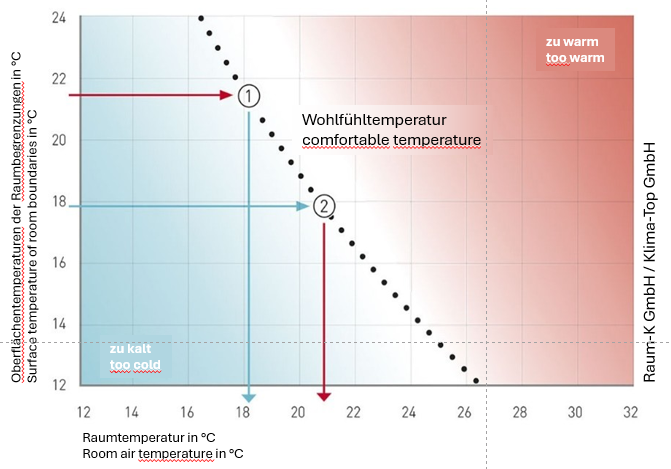
➀ With envelope surface temperatures of around 22°C, the ideal indoor climate is achieved with an air temperature of just under 18°C.
➁ At envelope surface temperatures of 18°C, an air temperature of approx. 21°C is required to achieve the same thermal comfort.
Source: Prof. Fanger, Dänemark
The Full-Surface Climate Ceiling as a Turbo for the Heat Pump
The principle of a heat pump is extremely clever: The pump uses electrical power not directly for heating and cooling, but to make additional energy from the ground, groundwater, or air usable.
This multiplies the energy used. It achieves the highest efficiency when it only needs to slightly raise or lower the flow temperature. In heating mode, a low flow temperature significantly increases energy efficiency.
Full-surface activated climate ceilings increase the COP of the heat pump
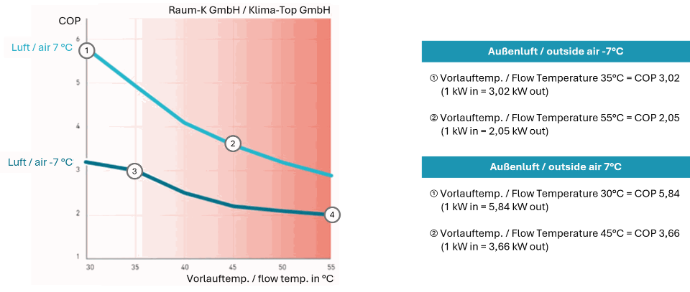
The lower the temperature differences, the more efficiently a heat pump operates. If it needs to heat the circulating water by only 10 Kelvin instead of 20 Kelvin, it requires significantly less energy, not just half.
The greatest savings potential in heating mode thus arises from the lowest possible flow temperature, as this allows the heat pump to achieve a higher efficiency.
To achieve high performance despite low flow temperature, the active heating surface must be correspondingly large. And the largest activatable surface is the ceiling.
"Wait a minute! Doesn't the ceiling have the same area as the floor?"
Correct, but a large part of the floor is occupied by furniture. These areas contribute less or not at all to heat transfer. The floor structure and carpets also have an insulating effect and can further limit performance.
The ceiling, on the other hand, usually remains completely free: With the same heating and cooling performance, it increases the efficiency of the heat pump and gives you complete freedom in floor and room design.
Lower Flow Temperatures Lead to Reduced Energy Costs and Higher Self-Sufficiency
The graphics compare the energy expenditure of a heat pump to maintain an operational room temperature of 20°C with a climate ceiling and underfloor heating. On the left, in a well-insulated new building in Oberried, and on the right, in a renovated old building in Rostock without external thermal insulation composite system (ETICS).
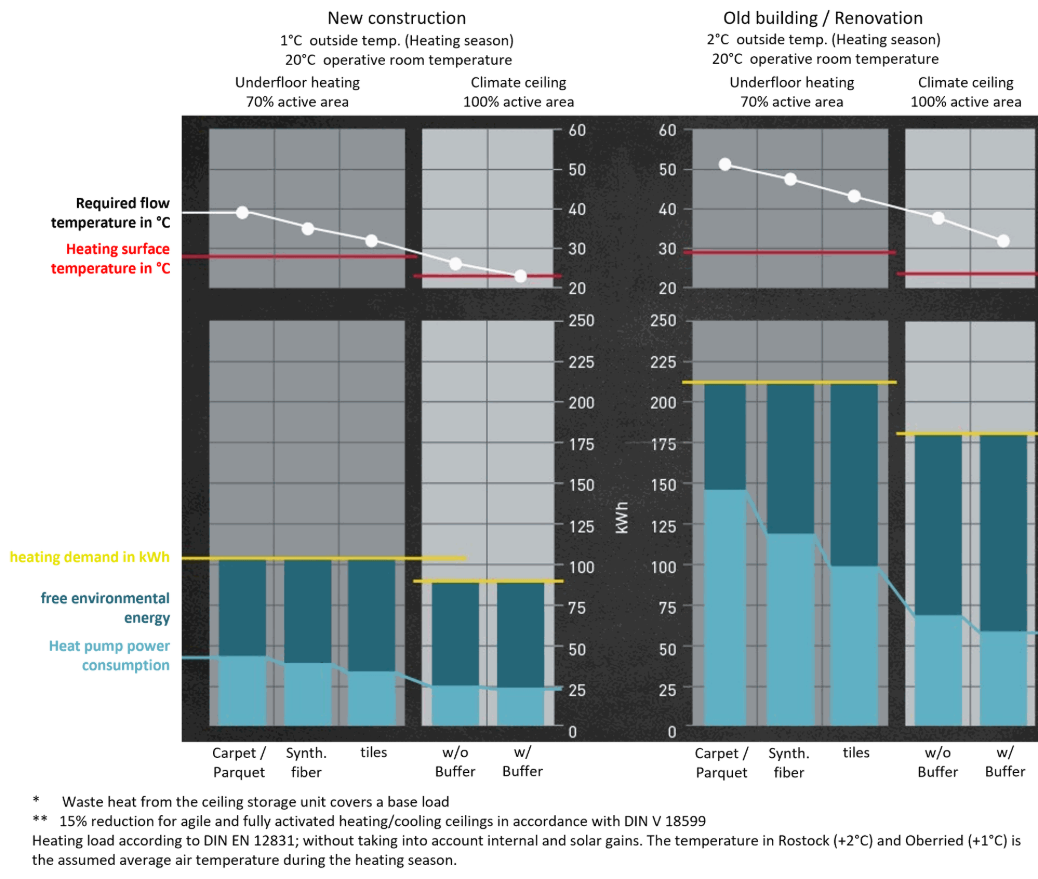
- The climate ceiling requires significantly lower flow temperatures than underfloor heating to achieve the same operational room temperature.
- The lower the flow temperature, the less drive power the heat pump needs and the more energy it gains from the environment.
- Ceiling storage can further increase the efficiency of the climate ceiling.
The heating load was calculated according to DIN EN 12831, i.e., without considering internal and solar gains. Therefore, all values are higher than they should be according to recognised technical rules. The standard outdoor temperatures for Rostock (2°C) and Oberried (1°C) are taken from the appendix of this standard and correspond to the lowest 2-day average air temperature measured ten times within 20 years at these locations.
Climate Ceilings Improve Insulation
What is more beneficial, a new heating system or better insulation?
Questions like these often arise during renovation. Both can be elegantly combined: Climate ceilings not only temper the room more efficiently but also heat the enclosing surfaces more than other systems during heating operation. This dries the walls and thus improves their insulating properties.
Insulation is in our nature. We usually insulate ourselves - not out of vanity, but because body heat escapes more slowly when we put on a jumper. However, anyone who has been surprised by a rain shower knows: A wet insulator loses its effectiveness. Not only that: Wrapped in wet fabric, you end up freezing more than without insulation. This also applies to our buildings.
So, it's not just about applying the thickest possible layer of insulation but also about keeping it as dry as possible.
If you want to improve insulation, you can also dry the wall, and that's exactly what a climate ceiling does during heating operation. If the moisture content of the wall decreases by just 4%, the insulating effect already doubles.
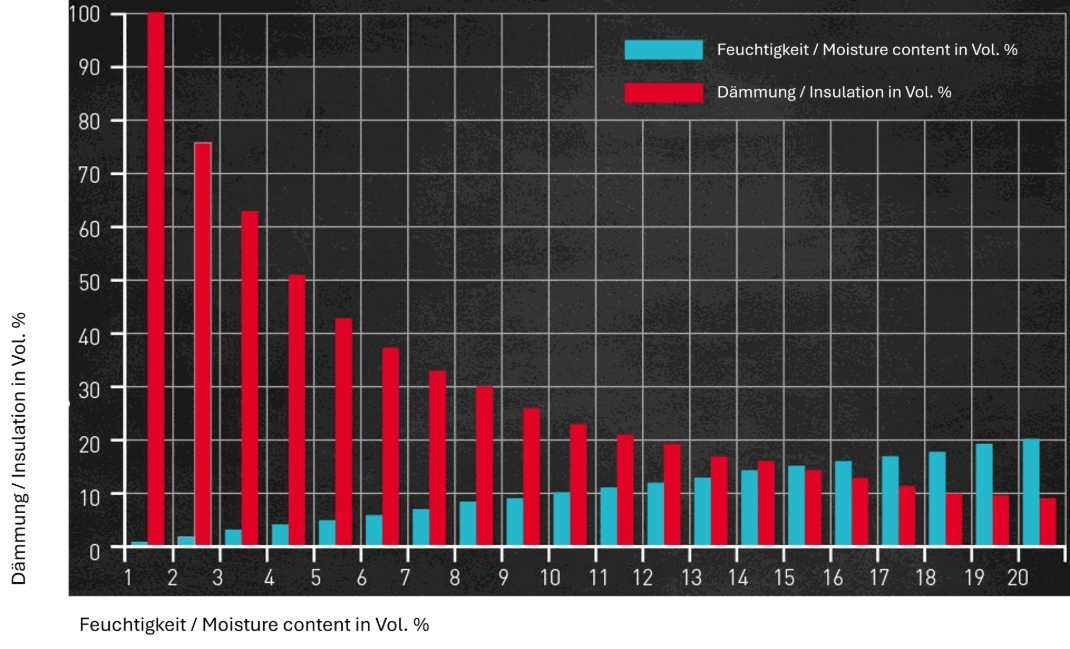
Full-Surface Activated Climate Ceilings Reduce CO2 Costs and Increase Self-Sufficiency
Thermal solar systems generate temperatures of 30°C even with low solar radiation in winter. Underfloor heating cannot provide the required heat energy to the rooms on this basis. This is because the required flow temperature of underfloor heating usually exceeds the mentioned 30°C, causing increased use of non-renewable energy sources. In contrast, the full-surface activated climate ceiling can often deliver the required heat input at 30°C, making it superior to all other systems.
Furthermore, this reduces the energy demand of a heat pump. CO2 emissions can often be reduced or avoided by 90% or more.
Full-Surface Activated Climate Ceilings Increase Your Independence
The low flow temperatures with which the climate ceiling comfortably tempers the rooms even on cold days not only lead to an extremely positive CO2 balance but also to self-sufficiency levels often exceeding 90%. The prerequisite for this is a coherent building energy concept that includes full-surface climate ceilings, a photovoltaic system, a solar thermal system, a ventilation system, and an intelligent building energy storage system. Our experts develop a building-specific system for you that offers maximum independence, optimal economy, and highest comfort.
The Full-Surface Activated Climate Ceiling All-Inclusive in Everyday Private Life
While the family goes about their daily obligations, the house works for them. The photovoltaic system collects solar energy and supplies the battery storage and the heat pump. In summer, the heat pump cools the apartment and stores excess cold. In winter, green electricity from the grid covers the additional demand. Thanks to intelligent control and storage, the family is almost energy self-sufficient and protects the environment with minimal energy consumption and maximum comfort.
Underfloor Heating
Underfloor heating has a long history. About 2,000 years ago, the Romans developed and used the principle under the name "Hypocaust". Through various stages of development, it has evolved into today's underfloor heating. It transfers heat approximately 50% through convection and 50% through radiation (source reference: ... with link).

The high convection proportion means that the air heats up at the floor and cools down again at the cooler ceiling surfaces and walls (source reference: ... including link). It has been proven that the room air is warmer than the surfaces of the room envelope, otherwise there would not be this permanent draft in the room.
This results in a number of disadvantages that can only be compensated for with much more effort and higher costs.
- Inertia
A major disadvantage of underfloor heating is its inertia. This means that it takes longer to heat up or cool down a room. - Limitations in Furnishing
Not all floor coverings are suitable for underfloor heating. Carpets, for example, can hinder heat transfer. Furnishing also restricts the use of underfloor heating. - Health
Allergy sufferers should consider that underfloor heating stirs up more fine dust, and therefore more dust mites are inhaled. - Draft / Chill Effect
Underfloor heating "fights" a "never-ending" battle against physics. Contrary to theDies führt dazu, dass die Fußbodenheizung im Vergleich zur Klimadecke in der Regel ca. 40 bis 50% mehr Energie benötigt, um ein vergleichbares Wärmeempfinden zu erzeugen. common belief that warm air rises, it is merely displaced by cooler air. Warm air weighs over 1 kg per cubic metre and, like all matter, is subject to gravity. This means it is attracted to the earth. However, if cooler air is present in a closed room, this cold air displaces the warm air from the floor and pushes it up against the ceiling. Therefore, underfloor heating inevitably leads to unpleasant air movements, including the stirring up of fine dust and house dust mites. This air movement means that the room air must be heated up to 4 degrees Celsius higher to achieve comparable comfort to the climate ceiling.
This means that underfloor heating generally requires about 40 to 50% more energy than the climate ceiling to create a comparable warmth sensation. - Damp Masonry
Warm room air threatens to transfer moisture to the cooler masonry. This creates a risk of mould, the insulation value of the masonry suffers, and additional heating energy is required.
This shows that there must be very good reasons to install underfloor heating or radiators. Instead of fighting against physics, we should work with physics and consistently utilise the enormous advantages of the full-surface activated ceiling heating.